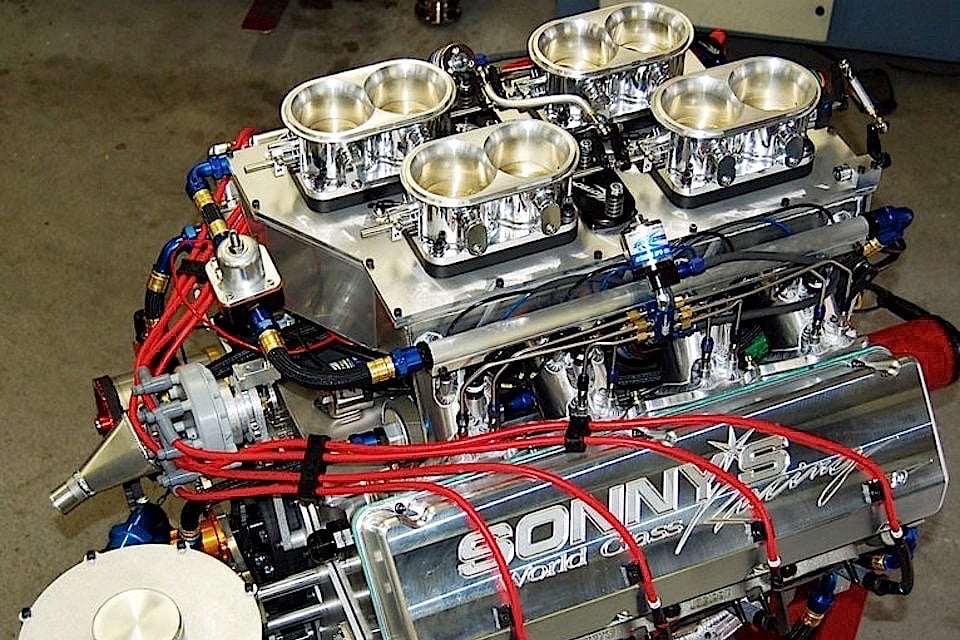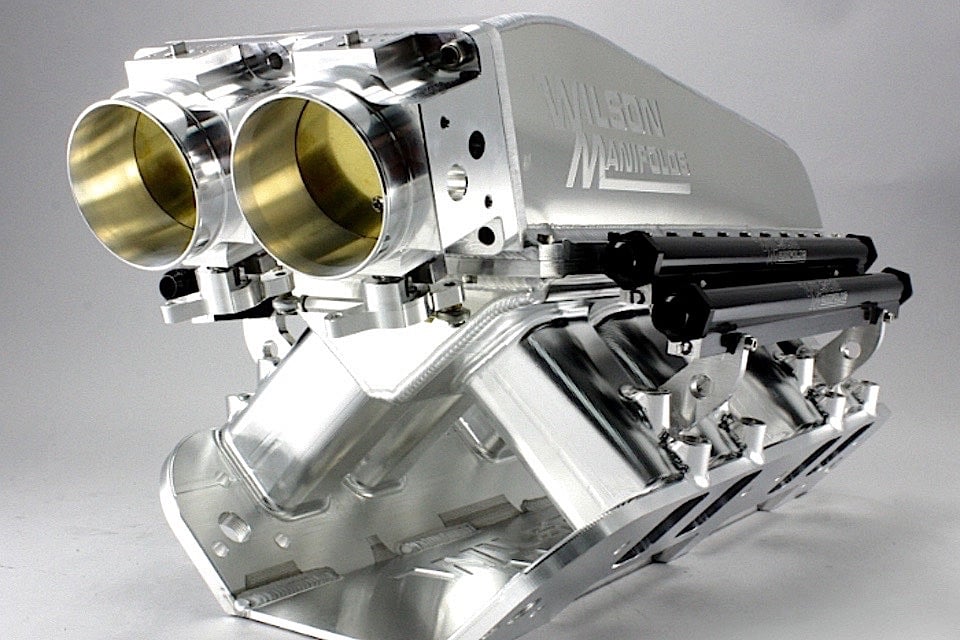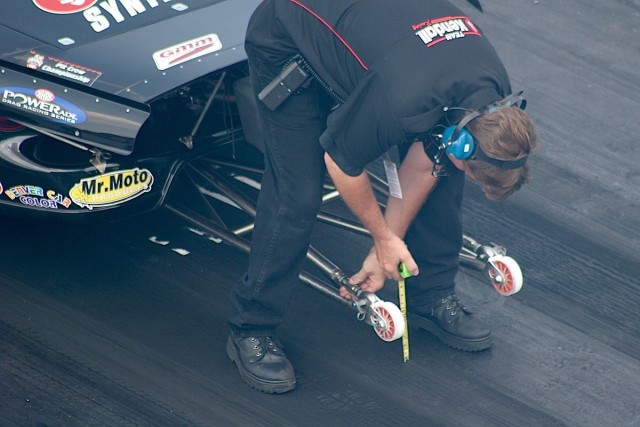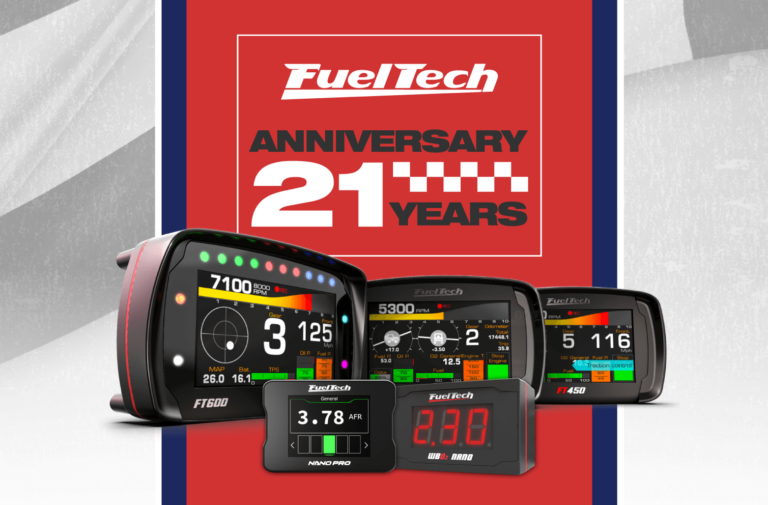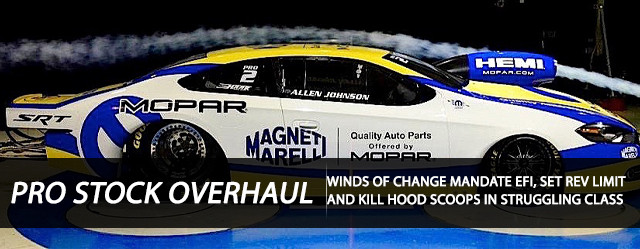 While the NHRA announced sweeping, albeit expected, changes for Pro Stock racers that include converting to electronic fuel injection and limiting engine speed to 10,500 rpm, the teams have little in the way of detailed technical requirements for guidance in implementing these new rules before they go into effect at the start of the 2016 season.
While the NHRA announced sweeping, albeit expected, changes for Pro Stock racers that include converting to electronic fuel injection and limiting engine speed to 10,500 rpm, the teams have little in the way of detailed technical requirements for guidance in implementing these new rules before they go into effect at the start of the 2016 season.

Here is ‘the sheet’ that NHRA handed out to Pro Stock racers Saturday before racing started at the Mopar Mile High Nationals.
“They (NHRA) have no specs, whatsoever,” says Nick Ferri, engine builder for Elite Motorsports.
As widely reported throughout the industry, the NHRA Saturday (July 25) set down a two-wave schedule of changes for Pro Stock–which like other pro divisions has been struggling with car counts and rising costs–that the sanctioning body says will increase spectator appeal and make the class more relevant to today’s production-car technology.
The first wave included directives for team behavior in the pits and burnout box along with a move to improve vehicle recognition. Those changes officially go into effect at the Sonoma Nationals starting next week, July 31, at the northern California event. However, some teams were already boasting on social media that they were complying a week early at the Mopar Mile High Nationals currently underway in Denver. More on these rule changes later.
In addition to the EFI and rev-limiter mandates, NHRA in 2016 will also require teams to eliminate the cars’ protuberant but iconic hood scoops and to shorten the wheelie bars. Again, no specifics were given, such as wheelie-bar length or if fresh air will now be drawn from the grille or cowl. But at least one team is eager to get started.
“This isn’t just me, it’s Elite Motorsports,” says Ferri. “We are not against the changes. There will there be obstacles to overcome and costs, absolutely. We’re going to do the best we can, but we’re going to race. We’re going to embrace it.”
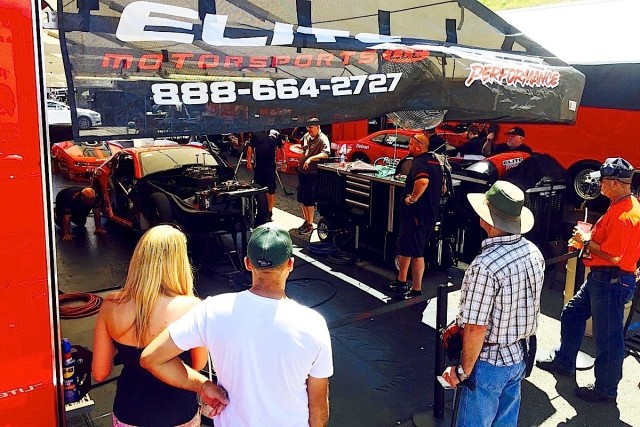
Elite Motorsports was one of many Pro Stock teams to remove the engine covers and bring its cars closer to the fans at Denver after NHRA announced rule changes for the class.
Look for more tech features on TV
The NHRA says it will work with new television partner Fox Sports to improve Pro Stock’s status on broadcasts with more profiles on teams and drivers, expanded on-track coverage and–hopefully this will come true–more technical features.
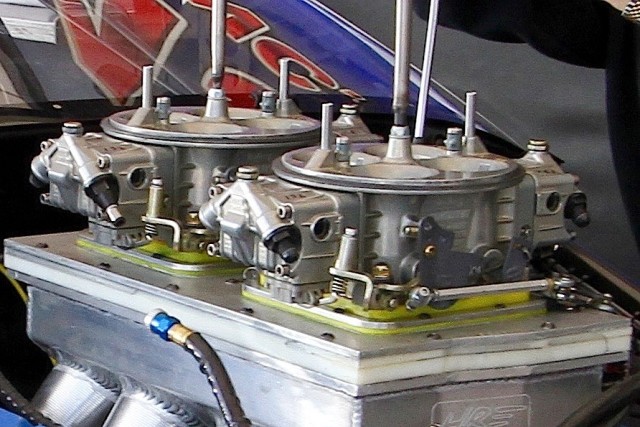
No more carburetors. Pro Stock teams invested heavily in carb development and even had to have separate sets for the dyno and track. Time will tell how much more development costs are needed to adapt EFI.
“Pro Stock racing has a tremendous history with NHRA and proves each weekend by the close side-by-side finishes that it is one of the most competitive forms of racing in all of motorsports,” says NHRA president Peter Clifford, NHRA president. “Through these changes we hope to provide a platform so the Pro Stock class can evolve from a technological standpoint, yet reconnect with its roots by generating more interest and appeal among spectators.”
Engine builders will be grapling with numerous issues once the EFI specifications are in place. As profiled earlier on EngineLabs, numerous questions are still unanswered regarding number, size and location of injectors, number and size of throttle bodies and the ECU. The NHRA has a couple of options for this decision. It can mandate a bespoke ECU and operating software, which makes sense so that tech inspectors can check for illegal programming, and then allow the teams to design a fuel system with the supplier of its choice around that spec control box. While NASCAR has a spec system, not all components are from one manufacturer. The ECU is from a collaboration of McLaren and Freescale, the injectors and Lambda sensors are from Bosch and the throttle body is from Holley.
What will manifold design be like under the new EFI rules? On the left is a Sonny Leonard 900-plus cubic-inch engine with four separate throttle bodies on top. On the right is a Wilson Manifold piece with dual throttle bodies up front. Lots of options but NHRA so far is mute on the technical details. Note that both these intakes have provisions for 16 injectors but in different arrangements.
Or NHRA could mandate a complete spec system right down to the size of the fuel rail from a single manufacturer. The only option for the teams would be manifold design, but that could be further restricted if officials dictate injector placement.
“I don’t know what the fuel injection by itself is going to do [to the team’s current engines]” says Ferri. “Obviously we are going to have manifold reconfiguration.”
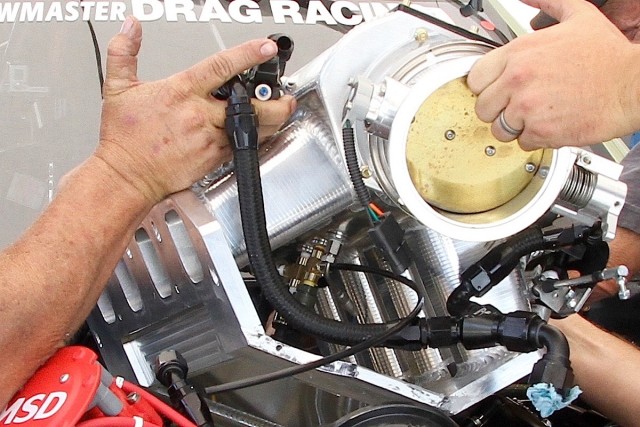
Here’s another Pro Mod intake set up with a giant single throttle body up front. It too could be a design inspiration as teams adapt EFI, depending on the rules package released on NHRA.
Allowing teams to work with a fuel-injection company of their choice would certainly add a little more drama and competitive spirit to the Pro Stock fraternity. It would bring more support and considerable expertise from the aftermarket to the class, all of which would eventually pass down new technology and product to the sportsman and consumer levels.
Seeing Holley, AEM, FAST, Big Stuff 3 and other EFI specialists in the pits and developing new product can only benefit the sport and industry, as a whole—but those companies won’t help unless there’s a chance their decals can be stuck to the front fender. Any monopoly on EFI will arguably hinder innovation, competitive spirit and potential excitement. Also, much of the current development of EFI for big-inch V8s has come from a variety of manufacturers working with Pro Mod and other classes that allow fuel injection. It would be quite a waste of expertise if they weren’t allowed in the game at the start of the new direction for Pro Stock.
“We know NHRA is talking with one, two, several manufacturers,” adds Ferri. “But we have a feeling they’re going to make it one system from one manufacturer. That would be a little bit of a disappointment. I think they want everyone to have the same parts to control costs. How well that can be policed is probably the biggest question.”
Rev limit is big hurdle for some teams
Perhaps the most the savage aftershock to the teams will be the 10,500-rpm rev limter that will be programmed into the EFI system.
“That also was a disappointment,” says Ferri. “I don’t know why they did the rev limit, because it has nothing to do with spectators or appeal. [The fans] have no idea if we’re turning these engines 6,000 or 12,000 rpm.”
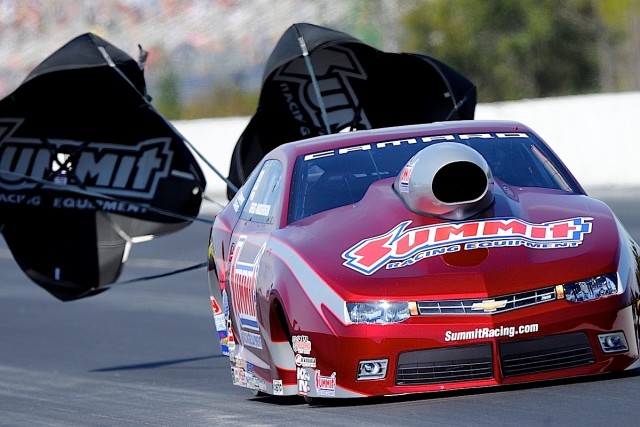
KB Racing is rumored to have the highest-revving engine in Pro Stock and could be challenged the most with the 10,500-rpm limit.
According to Ferri, one team is shifting close to 11,500 rpm and the Elite cars aren’t too far behind. Mandating an immediate 1,000 rpm drop to the high-revving teams will force serious strategy adjustments in engine design and vehicle setup.
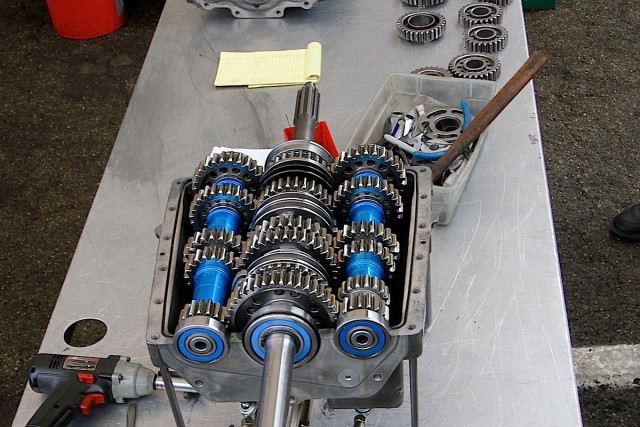
Teams will have to adjust gear ratios in the rear end and possibly in the 5-speed transmission to optimize their runs under the 10,500-rpm rev limit.
“Anytime you get a drop in RPM you have to change the gear ratio,” explains Ferri. “Our tranny will likely still work but the rear end stuff won’t.”
Pro Stock engines generally will fall back 2,000 rpm on each shift. A team shifting at 11,500 works with a power band roughly between 9,500 and 11,500 rpm.
“Right now I try to get as much power as possible in that 2,000-rpm range,” says Ferri. “It’s hard to say I’m concentrating just on torque, I’m concentrating on power under the curve. I’m just going to have to go back to the drawing board and get as much power as I can between 10-5 and 85.”

Teams will have more flexibility in cam timing with the implementation of EFI. Cam timing will also be crucial in adjusting the power curve under 10,500 rpm. Note that Pro Stock cams have nine cam bearings.
Getting air to the engine
Recent trends in Pro Stock engine design has seen builders open up cylinders to the maximum diameter that the 4.9-inch bore-limits allow and go with the shortest stroke possible. That strategy may change now with teams seeking to manipulate the power curve with a longer stroke crankshaft. But then costs come into play as teams would have to order new blocks that require extensive machining and expensive billet crankshafts.
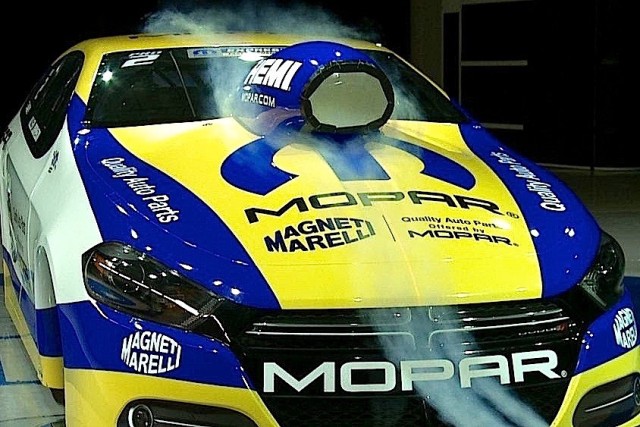
Plenty of wind-tunnel and CFD development was logged in designing today’s Pro Stock hood scoop. The scoop will add parasitic drag to the vehicle at high speeds, but it also helps charge the air into the carbs to improve power.
“At this point I can say camshaft, valve springs, and manifold to get back to those lower rpm limits,” says Ferri. “But for some teams it might be more mechanical.”
Despite the challenges to current teams adapting a rev limiter, there could be an upside to the lower engine speed. Teams running older engines in a Pro Stock-legal Comp car could theoretically make a few upgrades and have a shot at qualifying. Or respected Pro Stock engine builders who have retired from the class may have enough weapons in their arsenals to build a competitive engine that doesn’t require hundreds of thousands of dollars worth of R&D to spin the motor upwards of 11,500 rpm.
On the other rules, NHRA hasn’t set direction for getting air to the engine without a hood scoop. It could come from cowl induction, but there hasn’t been any talk of bodywork dimensions or how the air can be routed to the throttle body(s). Another possibility drawing air straight through a grille opening, but dimensions are still missing along with routing.
“We’d need a spec air pan so it doesn’t get out of control like it did with Pro Stock Truck,” remembers Ferri.
Additional changes on car and in the pits
Finally, there’s the wheelie bar. The NHRA says a shorter wheelie bar will “boost spectator appeal by increasing the unpredictability of the class through more ‘wheels up’ launches from the starting line.” Just how far the wheelie bars will be tucked under the deck lid has yet to be determined, but the chassis tuners will be somewhat as challenged as the engine tuners under the new rules. Despite outward appearances and the fact they go only in a straight line for 1,320 feet, a Pro Stock chassis and suspension is rather sophisticated. Consider the different wheelbase on each side of the car, electronic rear shocks, fully adjustable 4-link and adjusting the height of the wheelie bars. It’s a concert of minute, incremental adjustments on what is virtually a 6-wheel vehicle. Get the wheelie bars right and you carry the front end off the ground up through second and third gear, placing all the vehicle’s weight on the rear tires for maximum traction. Hit the wheelie bars with too much vehicle weight and the rear tires could unload and break free. Whether or not the cars will start dragging the rear bodywork with wheelies at the start is still questionable.
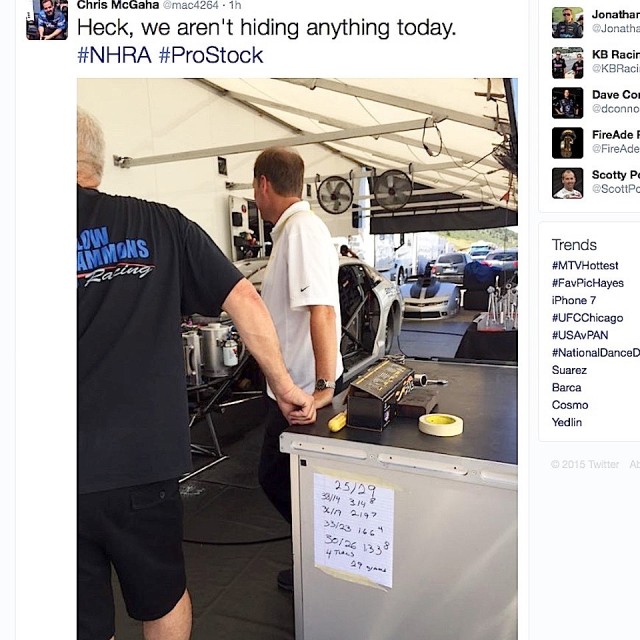
Chris McGaha was one of the first to turn his car around in the pits. He even tweeted a photo of the car’s setup notes clearly visible to show he had nothing to hide.
As mentioned earlier, the NHRA announced changes that were scheduled to go into effect next week in California but many teams are already abiding by them. These new rules require teams to back their cars into the pits with no protective covers on the body or engine bay. The cars can’t be parked more than 10 feet away from the crowd-restraining barrier with the goal of getting the fans to interact more with the teams and drivers.
“We’ve already backed the cars in and taken the drapes off,” Ferri told EngineLabs from the pits Saturday morning after NHRA released the new rules. “Not going to matter if it’s this weekend or next weekend.”
Crews are also banned from standing beside the cars to hold them in place at the start of a burnouts, and the cars will be required to have manufacturer decals on the windshield headers. The GM teams already do this with the Camaro, it’s just a matter of the Dart teams from FCA cutting the stencils.
Future of Pro Stock?
Despite NHRA’s rather positive and certainly assertive move to enhance the class, speculation about the future of Pro Stock remains clouded in a storm of rumors about replacing the current format with more powerful versions of the Factory Showdown cars.
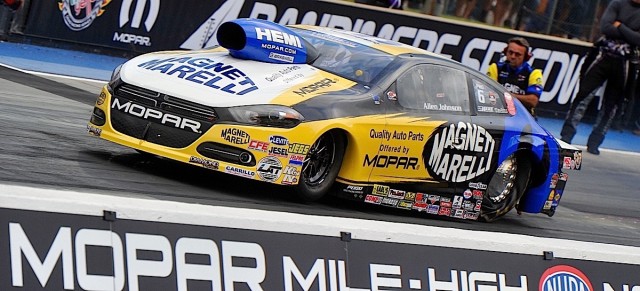
Allen Johnson set the fastest qualifying time at the Mopar Mile-High Nationals, the same weekend the NHRA announced sweeping changes for Pro Stock.
“All this speculation online as far as within three years they’re phasing out this and they’re going to co-exist with other things, that’s not even on the board,” sums up Ferri. “Allen Johnson brought that up (in the Denver meeting when NHRA made the announcement) as far as the future. All [NHRA VP of racing operation Graham Light] said is that, ‘I suggest you concentrate on this sheet.’
“If they veer away from the 500-inch motor,” adds Ferri. “Pro Stock will probably go away.”
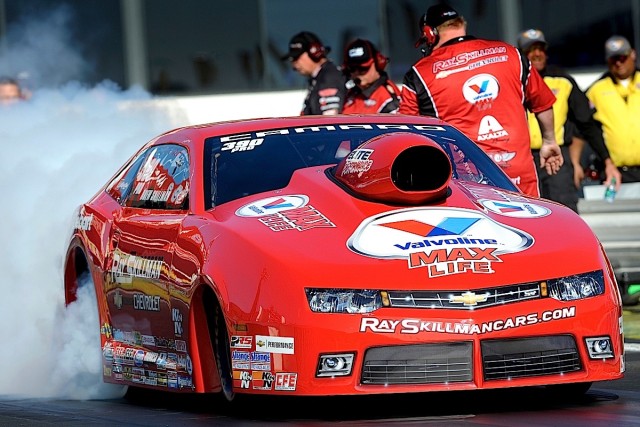
Cars will be required to have manufacturer ID badging on the windshield, just as Drew Skillman boasts on his Camaro. NHRA photo



